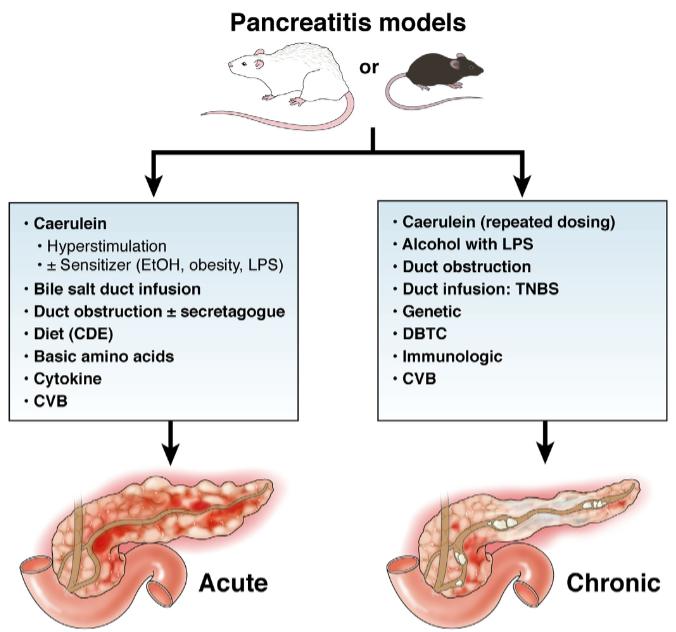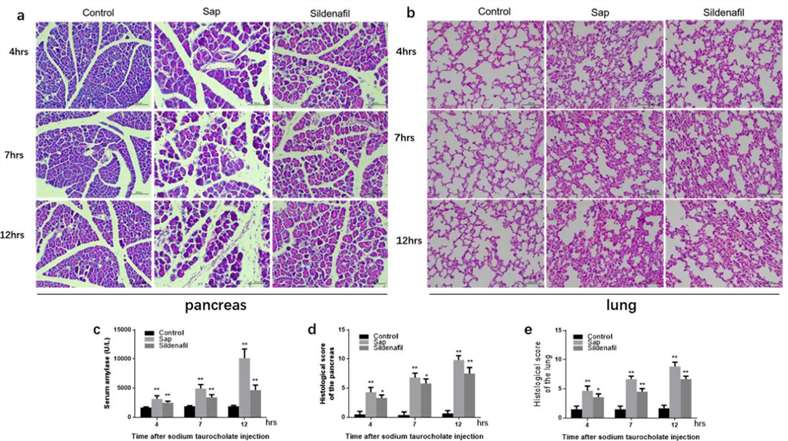Pancreatitis Model
If you are looking for reliable and experienced assistance in conducting preclinical studies in pancreatitis, Creative Bioarray can help. We offer top-notch consultancy services and preclinical models for pancreatitis to help you make informed decisions based on solid data. With our scientific expertise in pancreatitis and extensive experience in animal models, you can trust us to provide you with the best possible support to achieve your research goals.
Chronic and acute pancreatitis are prevalent gastrointestinal conditions that significantly impact morbidity and life expectancy. Despite advancements in supportive care over the past two decades, there remains a dearth of specific and effective pharmacological treatments, primarily due to the incompletely understood pathobiology of the disease.
Experimental animal models have served as valuable tools in pancreatitis research for over a century. In recent years, rodent models (particularly rats and mice) have become the most commonly utilized in pancreatitis studies. These animals are relatively inexpensive to maintain, easy to manipulate, widely accessible, and capable of inducing moderate to severe pancreatic injury. These experimental models not only offer an avenue for mechanistic studies but also facilitate the development of therapeutic strategies, thus paving the way for potential improvements in the management and treatment of pancreatitis.
 Fig. 1 Rodent models most commonly used to study acute and chronic pancreatitis.
Fig. 1 Rodent models most commonly used to study acute and chronic pancreatitis.
Our Animal Models of Pancreatitis
For pancreatitis research, there are a number of well-characterized animal models. As a research partner specialized in designing pharmacology and efficacy studies for different digestive diseases, Creative Bioarray can utilize the following models for the evaluation of potential therapeutics:
- Cerulein-Induced Pancreatitis Model
- Sodium Taurocholate-Induced Pancreatitis Model
- Dibutyltin Dichloride (DBTC) Induced Pancreatitis Model
Example Data
 Fig. 2 Morphological changes and histopathological score of SAP-ALI. H&E sections were examined by light microscopy (original magnification, 200×). Neutrophil infiltration, hemorrhage, necrosis and edema in pancreas tissues were observed. In lung tissues, hemorrhage, neutrophil infiltration and alveolar wall thickening were observed (a–b). The pathological scores of pancreas and lung (d–e). Serum amylase (c).
Fig. 2 Morphological changes and histopathological score of SAP-ALI. H&E sections were examined by light microscopy (original magnification, 200×). Neutrophil infiltration, hemorrhage, necrosis and edema in pancreas tissues were observed. In lung tissues, hemorrhage, neutrophil infiltration and alveolar wall thickening were observed (a–b). The pathological scores of pancreas and lung (d–e). Serum amylase (c).
References
- Fang, D., et al. Effects of sildenafil on inflammatory injury of the lung in sodium taurocholate-induced severe acute pancreatitis rats. International immunopharmacology, 2020, 80: 106151.
- Yang, X., et al. Experimental acute pancreatitis models: history, current status, and role in translational research. Frontiers in Physiology, 2020, 11: 614591.
- Lerch, M.M., Gorelick, F.S. Models of acute and chronic pancreatitis. Gastroenterology, 2013, 144(6): 1180-1193.
For research use only. Not for any other purpose.
Disease Models
- Oncology Models
-
Inflammation & Autoimmune Disease Models
- Rheumatoid Arthritis Models
- Glomerulonephritis Models
- Multiple Sclerosis (MS) Models
- Ocular Inflammation Models
- Sjögren's Syndrome Model
- LPS-induced Acute Lung Injury Model
- Peritonitis Models
- Passive Cutaneous Anaphylaxis Model
- Delayed-Type Hypersensitivity (DTH) Models
- Inflammatory Bowel Disease Models
- Systemic Lupus Erythematosus Animal Models
- Oral Mucositis Model
- Asthma Model
- Sepsis Model
- Psoriasis Model
- Atopic Dermatitis (AD) Model
- Scleroderma Model
- Gouty Arthritis Model
- Carrageenan-Induced Air Pouch Synovitis Model
- Carrageenan-Induced Paw Edema Model
- Experimental Autoimmune Myasthenia Gravis (EAMG) Model
- Graft-versus-host Disease (GvHD) Models
-
Cardiovascular Disease Models
- Surgical Models
- Animal Models of Hypertension
- Venous Thrombosis Model
- Atherosclerosis model
- Cardiac Arrhythmia Model
- Hyperlipoidemia Model
- Doxorubicin-induced Heart Failure Model
- Isoproterenol-induced Heart Failure Model
- Arterial Thrombosis Model
- Pulmonary Arterial Hypertension (PAH) Models
- Heart Failure with Preserved Ejection Fraction (HFpEF) Model
-
Neurological Disease Models
- Alzheimer's Disease Modeling and Assays
- Seizure Models
- Parkinson's Disease Models
- Ischemic Stroke Models
- Acute Spinal Cord Injury (ASCI) Model
- Traumatic Brain Injury (TBI) Model
- Hypoxic-Ischemic Encephalopathy (HIE) Model
- Tourette Syndrome (TS) Model
- Amyotrophic Lateral Sclerosis (ALS) Model
- Huntington's Disease (HD) Model
- Intracerebral hemorrhage (ICH) Models
- Schizophrenia Model
- Pain Models
-
Metabolic Disease Models
- Type 1 Diabetes Mellitus Model
- Type 2 Diabetes Mellitus Model
- Animal Model of Hyperuricemia
-
Nonalcoholic Fatty Liver Disease Model
- High-Fat Diet-Induced Nonalcoholic Fatty Liver Disease (NAFLD) Model
- Methionine and Choline Deficient (MCD) Diet-Induced Nonalcoholic Fatty Liver Disease (NAFLD) Model
- Gubra-Amylin NASH (GAN) Diet-Induced Nonalcoholic Fatty Liver Disease (NAFLD) Model
- Streptozotocin (STZ) Induced Nonalcoholic Fatty Liver Disease (NAFLD) Model
- High Fat Diet-Induced Obesity Model
- Diabetic Foot Ulcer (DFU) Model
- Liver Disease Models
- Rare Disease Models
- Respiratory Disease Models
- Digestive Disease Models
-
Urology Disease Models
- Cisplatin-induced Nephrotoxicity Model
- Unilateral Ureteral Obstruction Model
- 5/6 Nephrectomy Model
- Renal Ischemia-Reperfusion Injury (RIRI) Model
- Diabetic Nephropathy (DN) Models
- Passive Heymann Nephritis (PHN) Model
- Adenine-Induced Chronic Kidney Disease (CKD) Model
- Kidney Stone Model
- Doxorubicin-Induced Nephropathy Model
- Orthotopic Kidney Transplantation Model
- Orthopedic Disease Models
- Ocular Disease Models
- Skin Disease Models
- Infectious Disease Models
- Otology Disease Models